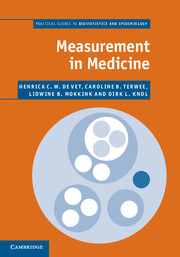Book contents
- Frontmatter
- Contents
- Preface
- 1 Introduction
- 2 Concepts, theories and models, and types of measurements
- 3 Development of a measurement instrument
- 4 Field-testing: item reduction and data structure
- 5 Reliability
- 6 Validity
- 7 Responsiveness
- 8 Interpretability
- 9 Systematic reviews of measurement properties
- References
- Index
8 - Interpretability
Published online by Cambridge University Press: 07 September 2011
- Frontmatter
- Contents
- Preface
- 1 Introduction
- 2 Concepts, theories and models, and types of measurements
- 3 Development of a measurement instrument
- 4 Field-testing: item reduction and data structure
- 5 Reliability
- 6 Validity
- 7 Responsiveness
- 8 Interpretability
- 9 Systematic reviews of measurement properties
- References
- Index
Summary
Introduction
After addressing the development of measurement instruments in Chapters 3 and 4 and evaluating measurement properties (i.e. reliability, validity and responsiveness) in Chapters 5–7, it is time to pay attention to the interpretability of the scores when applying the measurement instruments. For well-known instruments, such as blood pressure measurements and the Apgar score, the interpretability will cause no problems, but for new or lesser known instruments this may be challenging. This particularly applies to the scores for multi-item measurement instruments, the meaning of which is not immediately clear. For example, in a randomized trial on back pain carried out in the United Kingdom, the effectiveness of exercise therapy and manipulation was compared with usual care in 1334 patients with low back pain. The researchers used the Roland–Morris Disability Questionnaire (RDQ) to assess functional disability (UK BEAM trial team, 2004). The RDQ has a 0–24-point scale, with a score of 0 indicating no disability, and 24 indicating very severe disability. The mean baseline score for the patients with low back pain was 9.0. In the group who received usual care, the mean RDQ value decreased to 6.8 after 3 months, resulting in an average improvement of 2.2 points. This gives rise to the following questions: What does a mean value of 9.0 points on the 0–24 RDQ scale mean? In addition, is an improvement of 2.2 points meaningful for the patients? The primary focus of this chapter is on the interpretability of scores and change scores on a measurement instrument. In other words, the aim is to learn more about the measurement instrument, and not about the disease under study.
- Type
- Chapter
- Information
- Measurement in MedicineA Practical Guide, pp. 227 - 274Publisher: Cambridge University PressPrint publication year: 2011
- 9
- Cited by



